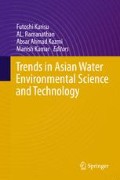Abstract
Characteristics of canteen wastewater and other commercial food service facilities differ significantly from residential wastewater. Due to its high amount of organic matter, oil and grease and suspended solids, it causes higher biochemical oxygen demand (BOD). Oil and grease present in a form of low-biodegradable and frequently cause problems for both on site sewage disposal systems and public sewer systems. The water in contact with the free oil and grease (FOG) had high levels of oil approximately 800 mg/L and this may indicate the poor FOG management practices (Williams et al. 2012). Oil and grease in wastewater can exist in several forms: free, dispersed or emulsified. The differences are based primarily on size. In an oil-water mixture, free oil is characterized with droplet sizes greater than 150 μm in size while dispersed oil has a size range of 20–150 μm and emulsified oil has droplets typically less than 20 μm (Hu 2002). The majority of oil in canteen wastewater is free oil which can be removed by an overflow weir grease trap (Pollution Prevention Regional Information Center 2014). A grease trap is a chamber designed for wastewater pass through and allow any free or mechanically emulsified oil to float to the surface. Then clear wastewater can be treated in the next wastewater treatment unit. Although grease trap tanks are supposed to prevent oil and grease to enter the sanitary sewer line, high grease loads, emulsified grease, and surge wastewater loadings often cause oil and grease bypass the grease trap tanks. Some researchers found that grease trap tanks showed the removal efficiency between 43 and 80 % (Wong et al. 2007; Wongthanate et al. 2014).
Access this chapter
Tax calculation will be finalised at checkout
Purchases are for personal use only
Preview
Unable to display preview. Download preview PDF.
References
Biowish Technologies Inc. (2014). Introduction to Biowish: Aquaculture. Biowish Technologies Inc., Ohio, United States.
Cammarota, M.C. and Freire, D.M.G. (2006). A review on hydrolytic enzymes in the treatment of wastewater with high oil and grease content. Biores. Tech., 97(17): 2195–2210.
Hu, X. (2002). Separation of Oil-in-Water Emulsion for Environmental Protection. Ph.D. thesis, Department of Environmental Economics, Szent István Egyetem, Élelmiszertu-dományi Doktori Iskola.
Jeganathan, J., Bassi, A. and Nakhla, G. (2006). Pre-treatment of high oil and grease pet food industrial wastewaters using immobilized lipase hydrolyzation. J. Haz. Mat., 137(1): 121–128.
Karia, G.L. and Christian, R.A. (2006). Design of preliminary treatment units. In: Wastewater Treatment: Concepts and Design Approach. Prentice-Hall of India, New Delhi.
Pollution Prevention Regional Information Center (2014). Guidelines for Design, Installation, and Construction of North Carolina Food Establishments. Pollution Prevention Regional Information Center, Omaha, United State.
Wakelin, N.G. and Forster, C.F. (1997). An investigation into microbial removal of fats, oils and greases. Biores. Tech., 59(1): 37–43.
Williams, J.B., Clarkson, C., Mant, C., Drinkwater, A. and May, E. (2012). Fat, oil and grease deposits in sewers: Characterisation of deposits and formation mechanisms. Water Res., 46(19): 6319–6328.
Wong, N.H., Law, P.L. and Lai, S.H. (2007). Field tests on a grease trap effluent filter. Int. J. Environ. Sci. Tech., 4(3): 345–350.
Wongthanate, J., Mapracha, N., Prapagdee, B. and Arunlertaree, C. (2014). Efficiency of modified grease trap for domestic wastewater treatment. J. Indus. Tech., 10(2): 10–22.
Author information
Authors and Affiliations
Corresponding author
Editor information
Editors and Affiliations
Rights and permissions
Copyright information
© 2017 Capital Publishing Company, New Delhi, India
About this chapter
Cite this chapter
Kornboonraksa, T. (2017). Preliminary Study of Rapid Enhanced Effective Micro-organisms (REEM) in Oil and Grease Trap from Canteen Wastewater. In: Kurisu, F., Ramanathan, A., Kazmi, A., Kumar, M. (eds) Trends in Asian Water Environmental Science and Technology. Springer, Cham. https://doi.org/10.1007/978-3-319-39259-2_6
Download citation
DOI: https://doi.org/10.1007/978-3-319-39259-2_6
Published:
Publisher Name: Springer, Cham
Print ISBN: 978-3-319-39257-8
Online ISBN: 978-3-319-39259-2
eBook Packages: Earth and Environmental ScienceEarth and Environmental Science (R0)

